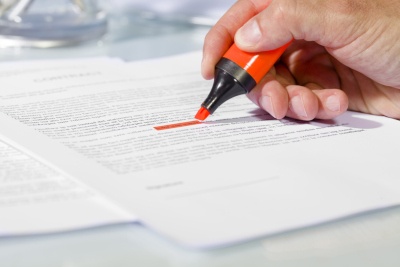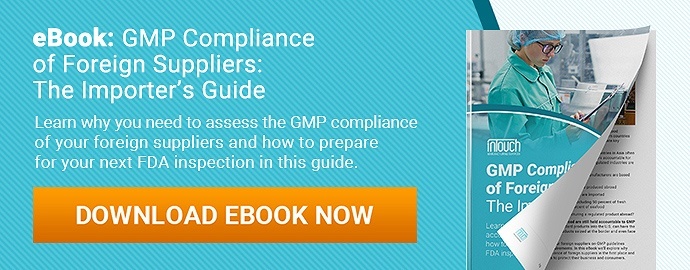 In 2011, U.S. Congress passed the Food Safety Modernization Act (FSMA) to promote a more preventative and risk-based approach to food safety.
In 2011, U.S. Congress passed the Food Safety Modernization Act (FSMA) to promote a more preventative and risk-based approach to food safety.
Four years later, the FDA published the final rule for the Foreign Supplier Verification Program (FSVP) to increase oversight of imported products. Compliance with the FSVP rule became mandatory for all food importers on May 30th, 2017.
Under the FSVP rule, an importer must ensure suppliers meet FDA food safety requirements and identify potential violations, such as product misbranding or adulteration. FSVP is a requirement specific to food importers, in addition to GMP compliance regulations applicable to all food manufacturers (related: GMP Compliance of Foreign Suppliers: The Importer’s Guide).
If you import food products, it’s essential you develop a FSVP plan as soon as possible. In the first year of mandatory compliance alone, FDA inspectors uncovered 108 failures to develop a FSVP among importers. In the long term, failure to comply can result in fines and refusal of your products at customs.
Let’s explore what you can do to ensure your suppliers are meeting specific FSVP requirements and how a professional third party can help.
What is the Foreign Supplier Verification Program (FSVP)?
Foreign Supplier Verification Program regulations are intended to ensure imported foods meet the same quality levels of food produced in the U.S. The FSVP process aims to improve food safety by increasing the importers’ responsibility for verifying foreign suppliers and their GMP compliance.
 The FDA has published a draft guidance for the Foreign Supplier Verification Program, which provides the most comprehensive set of requirements for importers to date.
The FDA has published a draft guidance for the Foreign Supplier Verification Program, which provides the most comprehensive set of requirements for importers to date.
Under FSVP requirements, importers must:
- Ensure supplier compliance with processes and procedures that provide at least the same level of public health protection as 21 CFR part 117: Current Good Manufacturing Practice, Hazard Analysis and Risk Based Preventative Controls for Human Food
- Ensure supplier compliance with processes and procedures that provide at least the same level of public health protection as 21 CFR part 112: Standards for the Growing, Harvesting, Packing and Holding of Produce for Human Consumption
- Ensure imported food is not adulterated
- Ensure imported food is not misbranded, with respect to major food allergens labelling
Compliance is mandatory for almost all importers of human and animal food into the U.S. And importers must develop a separate FSVP for each type of food imported and for each foreign supplier.
The relevant foreign supplier of the food products is considered the last entity in the foreign supply chain that conducts significant manufacturing or processing.
So if you work with a trading or distribution company that only holds or transports products, the foreign supplier you need to evaluate might not be who you directly purchase from.
How does the FDA assess FSVP compliance?
The FDA assesses compliance with FSVP through official FDA inspections at your place of business.
 But compared to traditional FDA facility inspections based on observations of production, FSVP-type FDA inspections are based on the review of records alone.
But compared to traditional FDA facility inspections based on observations of production, FSVP-type FDA inspections are based on the review of records alone.
Like with traditional FDA inspections, the FDA will send a warning letter to you if noncompliances are observed during inspection. And as with GMP regulations, the FDA will escalate enforcement and consequences depending on your responsiveness to the initial warning letter.
Are you exempt from FSVP compliance?
The development of an FSVP is mandatory for most food importers. But you’re exempt from FSVP requirements if the products you import are limited to any of the following:
- Fish and fishery products subject to the FDA’s hazard analysis and critical control point (HACCP) requirements
- Juice and its certain ingredients subject to HACCP requirements
- Alcoholic beverages and their certain ingredients
- Certain meat, poultry and egg products regulated by the USDA, not including live animals
- Food imported for research purposes, personal consumption, transshipment or exclusively for export
- Food contact substances
What must your FSVP plan include?
Your FSVP plan should be designed to determine known or reasonably foreseeable hazards in each type of food you import. You must develop a risk-based plan according to food types, potential hazards and supplier performance.
Aside from the following requirements, the FDA requires you to provide your name, email address and a unique facility identifier (UFI) for each line entry of imported food product. A line entry is the portion of a shipment listed as a separate item on an import entry document.
The FDA has recognized the Data Universal Numbering System (DUNS) number as an acceptable UFI for FSVP compliance. You can acquire a free DUNS number at FDAdunslookup.com.
There are four key steps to an effective FSVP plan:
1. Evaluate food risk and supplier performance
Your FSVP plan should evaluate the risk posed by a food, based on a hazard analysis and your foreign supplier’s performance.
Under FSVP requirements, your hazard analysis and supplier’s performance must be reevaluated at least once every three years or when new information comes to light, such as new hazards, facilities or violations.
Conduct a hazard analysis to identify food risk
The purpose of a hazard analysis is to identify potential food safety hazards your supplier must manage through controls.  A complete hazard analysis must assess:
A complete hazard analysis must assess:
- Biological hazards, including microbiological hazards, such as parasites, viruses and disease-causing bacteria
- Chemical hazards, including radiological hazards, pesticide and drug residues, natural toxins, food decomposition, unapproved food or color additives and food allergens
- Physical hazards, such as stone, glass and metal fragments and choking hazards
You might reference your prior experience with the product, illness data and scientific reports to conduct the hazard analysis.
Your hazard analysis should consider risks that could be introduced at any time, from formulation and processing to distribution and consumption. It must include an analysis of hazards that occur naturally in the product and those your supplier may unintentionally introduce or deliberately introduce for economic gain.
There are some types of food products for which there may be no hazards requiring a control. Under FSVP requirements, importers of these products must still conduct and document a hazard analysis to support this conclusion.
A compliant foreign supplier might be able to provide a hazard analysis to the importer. If your supplier can’t provide a hazard analysis, you’ll need to conduct one yourself or seek out a qualified third party or a trade association that might be able to provide one.
Evaluate supplier performance based on past GMP compliance
Consider your supplier’s procedures, processes, practices and prior history in relation to the FDA’s GMP food safety guidelines when evaluating their performance.
You might evaluate supplier performance by:
- Asking your supplier to fill out a survey or questionnaire regarding their operations and food safety plan
- Requesting and reviewing your supplier’s documentation and food safety plan
- Evaluating whether your supplier has ever been the subject of an FDA warning letter, import alert or other FDA compliance action related to food safety, through public records and information from your supplier
- Conducting a pre-approval site audit to assess their food safety processes and procedures
- Collecting a set of supplier risk management metrics based on several factors to score and evaluate supplier performance
If you’re evaluating a supplier you’ve already worked with in the past, the FDA lets you use your prior experience as reference of their food safety and GMP compliance. Gather any previous audit, inspection and sampling information as evidence of compliance.
2. Approve suppliers and determine appropriate supplier verification activities
The next step is to use your evaluation from step one to approve suppliers and determine appropriate supplier verification activities.
The FDA requires importers to document their approval of suppliers. Importers must establish and follow written procedures to ensure they import only from these approved foreign suppliers.
Documentation might include maintaining a paper or electronic list of approved suppliers. Procedures might include creating a receiving log where staff check the received goods against the approved list, log relevant information like dates and sign off on the shipment.
In addition to these documentation requirements for approving suppliers, you must also maintain written procedures regarding your intended verification activities after approval.
Verification procedures should reflect the results of the hazard analysis and supplier performance evaluation conducted in step one. The procedures should indicate how these results have informed your choice of verification activities.
Design verification activities to verify the hazards requiring a control in the imported food are significantly minimized or prevented. And conduct verification activities based on risk. This means the greater the risk of the hazard, the more robust the verification activity and the greater the frequency of the verification.
Tailor verification processes to the unique characteristics of your food product or supplier’s situation. Determining the appropriate verification methods is left completely to your discretion, but the FDA suggests considering the following factors:
- The hazard requiring a control
- The entities that will be applying or verifying hazard control
- Your foreign supplier’s processes, procedures and practices regarding food safety
- Applicable FDA food safety regulations and your supplier’s history of compliance
- Your foreign supplier’s food safety history, including any test and audit results
3. Conduct supplier verification activities on approved suppliers
You can conduct supplier verification activities on approved suppliers in several ways. Activities will vary based on your evaluations from step one and defined activities from step two.
Follow and record the written procedures you outlined in step two when conducting verification activities.
Supplier verification activities could include any combination of:
- Annual on-site audits of your supplier’s facility
- Sampling and testing of in-process materials, environmental samples or the food produced
- A review of your supplier’s relevant food safety records
The FDA expects importers to conduct an annual on-site audit of their foreign supplier as part of their verification activities when exposure to a hazard will likely result in serious adverse health consequences or death to humans or animals (SAHCODHA). You must explain your reasoning and document it for the FDA if you choose to forgo an annual audit.
Verification activities must also encapsulate the entire supply chain of the food products.
If your supplier sources a material or ingredient from a sub-supplier, design your verification activities to verify the sub-supplier is also controlling for hazards. This often means reviewing your supplier’s documentation of the verification activities they conduct on the sub-supplier’s processes and products.
The FDA allows suppliers to perform sample testing in an in-house laboratory, if they have one, or contract to an outside testing laboratory. But working with an accredited third-party laboratory for independent product testing often provides more reliable results than the supplier’s own laboratory.
4. Conduct corrective actions in response to identified hazards
The FDA requires importers to take corrective action if supplier verification activities reveal their supplier:
- Does not produce food in compliance with processes and procedures that provide at least the same level of public health protections as those required under section 418 or 419 of the FD&C Act; or
- Produces food that is adulterated under section 402 or misbranded under section 403 (w) of the FD&C Act
Appropriate corrective actions might include:
- Notifying the foreign supplier of the problem and requesting documentation of corrective actions the foreign supplier has taken
- Assisting the foreign supplier’s efforts to correct and prevent recurrence of the problem
- Issuing a recall of an adulterated or misbranded food
- Revising your FSVP
- Discontinuing use of the foreign supplier until they’ve demonstrated compliance
Like other FSVP requirements, the importer must document any corrective actions taken.
Many importers mistakenly believe it’s their supplier’s responsibility to take the initiative to implement corrective actions. While this is technically true, in reality, suppliers often take no action until their customers pressure them to do so.
And the FDA will hold you, not your supplier, accountable for ensuring corrective action is implemented.
How a third party can help importers with FSVP compliance
FSVP is yet another set of legal regulations for food importers. You might already be doing a lot to comply with the various safety regulations. And the thought of implementing another compliance program may seem daunting. But FSVP is a mandatory requirement you cannot afford to overlook.
The FDA does not allow you to rely on your foreign supplier’s own self audit as an appropriate verification activity.
But the good news is the FDA will accept third-party analyses, evaluations and activities for meeting FSVP requirements, provided that you review and assess corresponding documentation.
So if you don’t have local auditing staff based in your manufacturing country, hiring a professional third party might be a cost-effective compliance solution for your business.
You might hire a third party for:
- Supplier verification activities like GMP audits and product sample lab testing
- Reviewing, translating and assessing supplier documentation
- Communication and consulting support with foreign suppliers
The FDA requires third-party agents and auditors to be able to read and understand the language of any records they must review in performing a required FSVP activity. If your supplier keeps records in Chinese, for instance, the auditor reviewing the records must be proficient in Chinese.
The FDA has not yet established any required FSVP-specific courses, programs, certifications or other criteria for qualifying third parties. So while you have some flexibility in choosing a third party, it’s vital to properly vet their experience before hiring them.
Conduct a GMP audit to evaluate potential and existing suppliers
Many importers hire a third party to pre-audit potential or existing suppliers. A GMP pre-audit is conducted before an official FDA inspection date but generally mimics the same format as an official audit.
The FDA is flexible in the type of audit they’ll allow importers to use to fulfill supplier verification requirements. The audit must generally:
- Address applicable FDA food safety requirements; and
- Be conducted by an auditor qualified to perform the audit, based on relevant education, training and experience
A qualified auditor should be able to identify potential risks and document any noncompliance throughout the audit. Many auditors will issue your supplier a corrective action plan after the audit to correct observed violations.
You’ll generally need to re-audit suppliers after a time to verify whether they’ve implemented requested corrective actions. It’s rare for suppliers to proactively follow up on corrective actions without some oversight from their customer.
A qualified third-party auditing company should be able to develop a plan to ensure timely follow-up with your supplier to assess implementation of corrective actions. Sending your supplier a GMP audit checklist can also help your supplier understand the requirements they need to meet.
Conclusion
The FDA is currently focused on cooperating with food importers to develop a FSVP. Punishing importers for noncompliance is not the forefront goal of the FDA. But the FDA will likely increase enforcement as FSVP becomes more established.
There’s no better time to develop a FSVP than now. Consider using a third-party organization familiar with FSVP requirements if you’re having difficulty navigating FSVP compliance requirements on your own.
And don’t wait until you’re facing warning letters or fines to establish an FSVP in your organization!
FSVP is just one small part of ensuring the safety of your food products. Click the button below to learn how to evaluate your suppliers’ GMP compliance in our free eBook!







